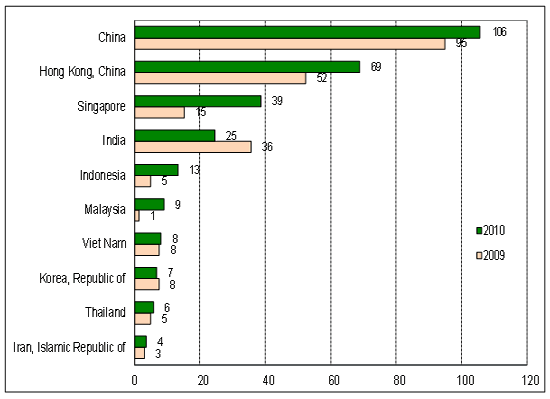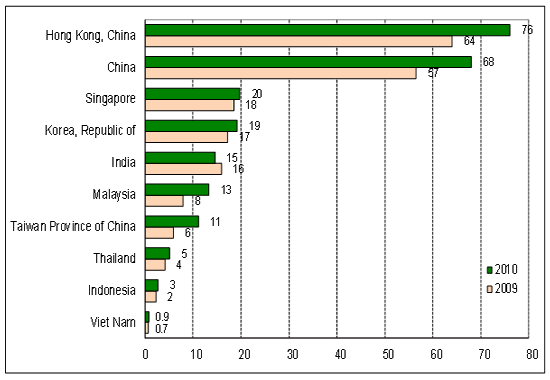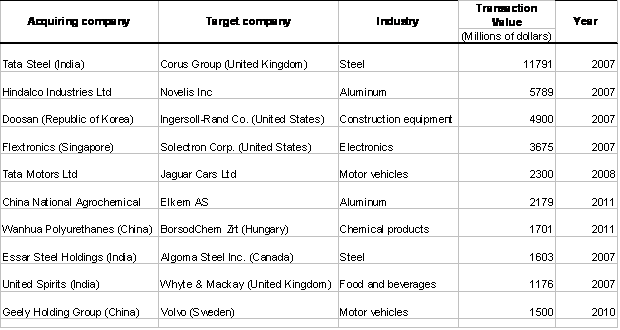| EMBARGO The contents of this press release and the related Report must not be quoted or summarized in the print, broadcast or electronic media before 26 July 2011,17:00 [GMT] (13:00 New York; 19:00 Geneva, 22:30 New Delhi, 02:00 - 27 July Tokyo) |
Geneva, 26 July 2011 - Developing Asia (excluding West Asia) set new records for FDI inflows and outflows in 2010, UNCTAD´s World Investment Report 2011(1) (WIR11) announces. The report, subtitled "Non-equity modes of international production and development", was released today.
In 2010, FDI inflows to South, East, and South-East Asia rose 24 per cent to $300 billion, nearly one fourth of the global total, the annual report says. However, the performance of the three subregions and their major economies varied significantly (figure 1):
- FDI to the member countries of the Association of Southeast Asian Nations more than doubled, reaching $79 billion in 2010. Proactive policy efforts at the country level contributed to the good performance of the group, and seem likely to continue to do so, the report says. Some ASEAN countries, for example, Indonesia and Viet Nam, have gained ground as low-cost production locations, especially for low-end manufacturing, while the region´s least developed countries (the Lao People´s Democratic Republic and Cambodia) received increasing inflows, particularly from neighbouring countries.
- FDI to East Asia rose to $188 billion, thanks to double-digit growth in inflows to China and Hong Kong (China). Inflows to China climbed by 11 per cent to $106 billion. China continues to experience rising wages and production costs, so that the trend in widespread offshoring of labour-intensive manufacturing to the country has slowed and FDI inflows are shifting towards high-technology industries and services.
- FDI to South Asia declined to $32 billion, reflecting a 31 per cent slide in inflows to India and a 14 per cent drop in flows to Pakistan. By contrast, inflows to Bangladesh, a rising low-cost production location, increased by nearly 30 per cent to $913 million.
FDI outflows from developing Asia grew by 20 per cent to about $230 billion in 2010, driven by increased investment coming out of China, Hong Kong (China), Malaysia, the Republic of Korea, Singapore and Taiwan Province of China (figure 1). Outflows from the region´s two largest FDI sources - Hong Kong (China) and China - increased by more than $10 billion each and reached historic highs of $76 billion and $68 billion, respectively. In 2010, China exceeded Japan for the first time in outward FDI, as well as in gross domestic product.
The region´s share in global FDI outflows has jumped from below 10 per cent before 2008 to around 17 per cent over the past two years. Companies from developing Asia have been actively taking over companies in the developed world, including through a number of very large acquisitions (table 1). However, they are facing increasing political obstacles, as illustrated by the failed attempts by Huawei (China) to take over 3Com and 3Leaf in the United States.
The significance of electronics in outward FDI from developing Asia reflects the international competitiveness of Asian companies in this industry, particularly the contract manufacturers, such as Foxconn (Taiwan Province of China) and Flextronics (Singapore). They have become a dominant force at the production stage of the global electronics value chain (see UNCTAD/PRESS/PR/2011/033).
Both inflows to and outflows from developing Asia are expected to continue to grow, the report predicts. Countries in the region have made considerable progress in their regional economic integration efforts. The report says that this will translate into a more favourable investment climate for intraregional FDI.
The World Investment Report and its database are available online at http://www.unctad.org/wir and http://www.unctad.org/fdistatistics and http://www.unctad.org/diae |
Overview in French
Overview in Spanish
Overview in Arabic
Overview in Russian
Overview in Chinese
ANNEX
Tables and figures
Figure 1. Top 10 recipients and sources of FDI flows in developing Asia, 2009, 2010(Billions of dollars)
a) FDI Inflows

b) FDI Outflows

Source: UNCTAD, World Investment Report 2011.
Note:Countries ranked on the basis of the magnitude of 2010 FDI flows.
Table 1. Selected M&A mega-deals in manufacturing undertaken by firms from developing Asia in developed countries, 2007-2011
Source: UNCTAD, World Investment Report 2011.
Abreviation:M&A - merger and acquisition


